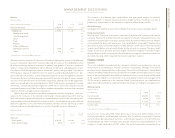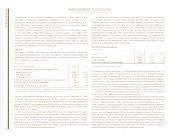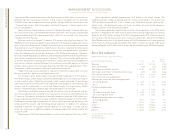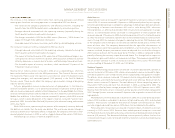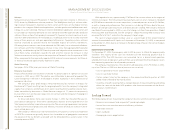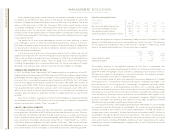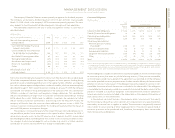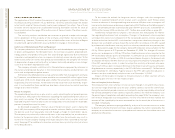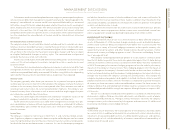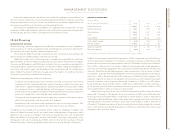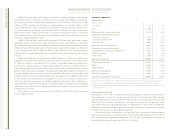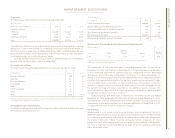IBM 2004 Annual Report Download - page 35
Download and view the complete annual report
Please find page 35 of the 2004 IBM annual report below. You can navigate through the pages in the report by either clicking on the pages listed below, or by using the keyword search tool below to find specific information within the annual report.
MANAGEMENT DISCUSSION
International Business Machines Corporation and Subsidiary Companies
33
ibm annual report 2004
To the extent actual estimated completed contract margins on percentage of completion
services contracts differ from management’s quarterly estimates by 1 percentage point, the
company’s consolidated net income would have improved/declined by an estimated
$69 million using 2004 results, depending upon whether the actual results were higher/
lower, respectively, than the estimates. This amount excludes any accrual resulting from
contracts in loss positions. For all long-term services contracts that have an estimated
completed contract profit of 5 percent or less, if actual profits were 5 percentage points
less than expected, the consolidated net income would be reduced by an estimated
$85 million.
Net Realizable Value and Client Demand
The company reviews the net realizable value of and demand for its inventory on a quar-
terly basis to ensure recorded inventory is stated at the lower of cost or net realizable value
and that obsolete inventory is written off. Inventories at higher risk for writedowns or write-
offs are those in the industries that have lower relative gross margins and that are subject
to a higher likelihood of changes in industry cycles. The semiconductor and personal
computer businesses are two such industries.
Factors that could impact estimated demand and selling prices are the timing and
success of future technological innovations, competitor actions, supplier prices and
economic trends.
To the extent that semiconductor and personal computer inventory losses differ from
management estimates by 5 percent, the company’s consolidated net income in 2004
would have improved/declined by an estimated $42 million using 2004 results, depending
upon whether the actual results were better/worse, respectively, than expected.
Warranty Claims
The company generally offers three-year warranties for its personal computer products
and one-year warranties on most of its other products. The company estimates the amount
and cost of future warranty claims for its current period sales. These estimates are used to
record accrued warranty costs for current period product shipments. The company uses
historical warranty claim information as well as recent trends that might suggest that past
cost information may differ from future claims.
Factors that could impact the estimated claim information include the success of the
company’s productivity and quality initiatives, as well as parts and labor costs.
To the extent that actual claims costs differ from management’s estimates by 5 per-
cent, consolidated net income will have improved/declined by an estimated $32 million in
2004, depending upon whether the actual claims costs were lower/higher, respectively,
than the estimates.
Income Taxes
The company is subject to income taxes in both the U. S. and numerous foreign jurisdic-
tions. Significant judgment is required in determining the worldwide provision for income
taxes. During the ordinary course of business, there are many transactions and calculations
for which the ultimate tax determination is uncertain. As a result, the company recognizes
tax liabilities based on estimates of whether additional taxes and interest will be due. To
the extent that the final tax outcome of these matters is different than the amounts that
were initially recorded, such differences will impact the income tax provision in the period
in which such determination is made.
To the extent that the provision for income taxes increases/decreases by 1 percent
of income from continuing operations before income taxes, consolidated income from
continuing operations would have declined/improved by $120 million in 2004.
currency rate fluctuations
Changes in the relative values of non-U.S. currencies to the U.S. dollar affect the company’s
results. At December 31, 2004, currency changes resulted in assets and liabilities denom-
inated in local currencies being translated into more dollars than at year-end 2003. The
company uses a variety of financial hedging instruments to limit specific currency risks
related to financing transactions and other foreign currency-based transactions. Further
discussion of currency and hedging appears in note l, “Derivatives and Hedging Transac-
tions,” on pages 65 to 67.
The company earned approximately 58 percent of its net income in currencies other
than the U.S. dollar. In general, these currencies appreciated against the U.S. dollar during
2004 so net income in these countries translated into more dollars than they would have
in 2003. The company also maintains hedging programs to limit the volatility of currency
impacts on the company’s financial results. These hedging programs limit the impact of
currency changes on the company’s financial results but do not eliminate them. In addition
to the translation of earnings and the company’s hedging programs, the impact of currency
changes also may affect the company’s pricing and sourcing actions. For example, the
company may procure components and supplies in multiple functional currencies and sell
products and services in other currencies. Therefore, it is impractical to quantify the impact
of currency on these transactions and on consolidated net income. For these reasons, the
company believes that extended periods of dollar weakness are positive for net income
and extended periods of dollar strength are negative, although the precise impact is diffi-
cult to assess.
For non-U.S. subsidiaries and branches that operate in U.S. dollars or whose economic
environment is highly inflationary, translation adjustments are reflected in results of opera-
tions, as required by SFAS No. 52, “Foreign Currency Translation.” Generally, the company
manages currency risk in these entities by linking prices and contracts to U.S. dollars and
by entering into foreign currency hedge contracts.
market risk
In the normal course of business, the financial position of the company is routinely subject
to a variety of risks. In addition to the market risk associated with interest rate and currency
movements on outstanding debt and non-U.S. dollar denominated assets and liabilities,
other examples of risk include collectibility of accounts receivable and recoverability of
residual values on leased assets.


